“The policies that created segregation have been so successful, that if you live in a white world, it’s kind of hard to see out of it. You just have to learn to see it.”
-Merlin Rainwater
Consider the following language. When was it written? Where was it written?
No person or persons of Asiatic, African or Negro blood, lineage, or extraction shall be permitted to occupy a portion of said property, or any building thereon; except domestic servants may actually and in good faith be employed by white occupants of such premises
No residence property shall at any time, directly or indirectly, be sold, conveyed, rented or leased in whole of in part to any person or persons not of the white or Caucasian race.
Tracts or parcels of land in this plat shall be used or occupied only by members of the white or Caucasian race, excluding Semites, and no other persons shall be permitted to use or occupy said tracts or parcels, except employees may occupy the premises where their employer resides.
From the 1920s to the 1940s, this language was widely written into deeds in housing stock not in Detroit, or Chicago, or St. Louis, but rather in Seattle. Now documented on the “Racial Restrictive Covenants” section of the Seattle Civil Rights & Labor History project at the University of Washington, much of this language—although outlawed by the 1968 Housing Rights Act—still exists on today’s home deeds, acting as a vestige of the racial restrictions that pervaded Seattle in the early 20th century. Despite that past ubiquity, many Seattle residents remain unaware of the ways in which the city was (and arguably still is) systematically racially segregated: through these restrictive covenants (private agreements made by white homeowners to exclude non-white and ethnically white residents), and through redlining.
Redlining, as many have documented, was the system begun in the 1930s by which the federal government worked with banks to spur the economy during and after the Great Depression. They did so through homeownership; in particular: racially restrictive homeownership. Banks drew up color-coded city maps based on existing and desired racial segregation. Banks then offered white residents seeking homes in white areas (areas drawn on the maps in green and blue) the best mortgage rates, and contrastingly, black residents seeking homes anywhere, but especially in black areas (drawn in red — hence the naming redlining), either no option for home loans, or exorbitantly high rates. Redlining took place in 239 cities across the U.S.; the process was backed by the federal government, invested money and wealth-making property into white people and neighborhoods, and divested from black and other non-white people.
Many residents of progressive-ish Seattle remain unaware about restrictive covenants redlining and their effects on the city today. Due to the growth of Amazon and other companies, Seattle has been the fastest growing city of the last decade. But that population growth took place without equitable urbanist policies in place. As such, many residents have dealt with drastically increased rents, lack of protections for vulnerable residents, displacement of non-white neighborhoods of color including the historically black Central District, and increased homelessness (an estimated 41% of Seattle’s homeless population is black). These changes and their racialized impact dialogue with past urbanist practices that dispossessed people of color from neighborhood space.
Merlin Rainwater, a Seattle-born resident, has been trying to change how Seattleites—in particular mostly white Seattleites—understand the history of race and racial dispossession within Seattle’s neighborhood spaces. Earlier this year, she launched the Red Line Rides, a bike tour (and subsequent walking tour) of redlining in Seattle. So much of her tours are about teaching white residents to, in her words, “learn to see” how and where white Seattle was built by systemic and racially restrictive practices, and the strong residues of those practices today. I interviewed her to learn more about the what, when, why, where and how of the tours.
Interview edited for clarity.
JASMINE MAHMOUD: Tell me about your history in Seattle. Where did you grow up? What are your initial memories of the city?
MERLIN RAINWATER: I was actually born in Seattle, but I grew up mostly in a little town … about 16 miles out of Seattle: Edmonds. We belonged to the Quaker meeting that met in Seattle, so I had a strong connection with the neighborhood around the University [of Washington], the University District. Both of my parents were born in Washington State. My father’s grandparents on his mother’s side were pioneer settlers outside of Seattle. And my mother’s parents homesteaded in Eastern Washington.
When I moved back to Seattle in 1974, Seattle was in the middle of a major recession, and it was pretty cheap to survive here. When I got married, my husband and I were able to buy a house, a very reasonably priced house in an area that had been redlined and that was on the margins on the Central District, the historically black part of Seattle. Looking back on it, almost 40 years now, we were really the first wave of white gentrifiers moving into the historically black part of town.
MAHMOUD: What was the Central District [historically African-American neighborhood] like when you moved there in the 70s?
RAINWATER: The neighborhood had been very hard hit by the recession. I had a girlfriend who bought a house nearby in 1976 for $3K. [Before she bought it], it had been repossessed and had stood empty for several years, and there were a number of other houses in similar conditions that young, liberal, white people had been able to buy. So by the time we bought our house, the neighborhood had stabilized quite a bit. … The people who’d lost their jobs … were gone. It was just a cusp of a boom in this area. So a couple of years after we bought our house, I counted 14 new houses that had been built within a three block area that were all fill ins of these undeveloped blocks.
MAHMOUD: Around what year was that?
RAINWATER: That was 1986 to ‘88 probably, when those houses were filled in. And when we moved here, probably about half of the families on the block were black, and then little by little those people left, moved out, sold their houses. As all these new houses were built and new people moved in, all of the new neighbors were white. One black family moved in next door to us, the year after we moved in here, but that’s the only black family that’s purchased a home. We have a long block with probably 30 houses. so it’s been a gradual but dramatic change. So when you’re in the middle of it, you don’t really see it.
Looking back on it, I recognize that one of the things that really struck me as I’ve been was trying to educate myself about all the issues related to segregation, I realized that my family and I have directly benefited from both the impoverished and the disinvestment in this neighborhood that happened over many years. Then the legislation that the city council passed in the 70s to outlaw redlining so by the time we were ready to buy a house in a previously redlined area, we were able to get a nice federally insured loan. Yeah, so that’s been a challenging bit of learning from the work that I’ve done.
MAHMOUD: How did you learn about redlining?
RAINWATER: We have a really wonderful project based out of the University of Washington called the Seattle Civil Rights & Labor History Project. They have a great little slideshow on Segregated Seattle, so I was aware of the general history, then I was aware of the campaign for open housing that had taken place in the mid sixties, but as a white person that knew about that, I was a rarity. And so when I went to visit the Douglass-Truth [Seattle Public] Library, which houses the African American collection and is located in the middle of the Central District, the historically black area, and I saw this nice display about the open housing campaign. I thought it’s great that they have this display, but this is not where it needs to be, people who live here and come to this library, they already know that. [Rather], it’s the people who benefited by the established by the fact that huge areas of Seattle were over 90% white until quite recently in its history.
If you look at population maps. Often, they are colored so that the presence of people of color shows up in more dramatic colors, but seeing a series of maps where what’s highlighted is the areas that are high percentage white, and it’s pretty much dramatic to look at all the parts of Seattle that were over 90% white until … If you weren’t white, you had no choice [where to live].
And so, people that lived within that little [redlined] sliver were forced into that part of the town. They knew what was going on. But if you were white and you lived in the vast rest of the city, you could be completely oblivious. Most people still are. Most white people still are.
MAHMOUD: Your tour animates what scholars like sociologist George Lipsitz (author of How Racism Takes Place) and urban planners J. Rosie Tighe and Joanna P. Ganning point out: that divestment in neighborhoods of color has long accompanied investment in white neighborhoods. You have said: “I thought, you know, this is information that really ought to be in Laurelhurst. It should be in Broadmoor … Because black people in the Central District, they know this history. It’s the white folks in the segregated white parts of the city that need to know that there was a struggle for open housing in Seattle.” What connections do you see between white and black areas in Seattle? How are these ideas animated on the tour?
RAINWATER: The section of the redline that I feature in the walk is an area on Capitol Hill, where there is actually quite a dramatic boundary between the affluent white, by racially covenanted north part of Capitol Hill, north of Roy and Aloha, and the redlined area to the south.
The area of Capitol Hill that’s south of Roy Street, basically, the character of the housing stock is not that different as you move east to west. There are modest, middle-class, pretty nice houses, but east of Roy Street, it was redlined and the only excuse for considering that area a bad investment was that black people lived there. The only thing that the surveyors bothered to point out was that there’s black people here. So on the one hand just a lack of contrast and they’re still fairly similar on both sides, but the lack of contrast is interesting.
Then as you go further north, the north of Roy and Aloha, a huge number of those lots had racially restricted covenants on them. And the sense that you get is that … and the houses are generally much larger and they look affluent. The fact that so many of the white folks in that part of town were afraid that black people might infiltrate, that they went through the trouble of getting together with all their neighbors and hiring a lawyer and drawing up a covenant that says “no Negroes can ever live in this place.” That’s dramatic. So to see the contrast in actual investment … I mean, the Central Area it’s sustained a very vibrant, middle-class black community that was mixed in with people of all economic conditions, but it wasn’t a terrible, general hell hole. So people had to work really hard to hold onto their properties and maintain their properties.
But at the same time, the investments that allowed white people to move out of the city and into the suburbs, you can’t actually see that when you’re standing on the line, I guess is what I’m trying to say. And I think that really is the challenge because the policies that created segregation have been so successful, that if you live in a white world, it’s kind of hard to see out of it. You just have to learn to see it.
MAHMOUD: Where did your idea for this tour come from? Why did it first start as a bike tour?
RAINWATER: So I started doing a series of bike rides that I call SLOW rides, Senior Ladies On Wheels, which is a fabulously brilliant acronym–
MAHMOUD Yes, it is.
RAINWATER: –because I have always used a bike as my main transportation, and I think it’s really the only sensible way to get around. I don’t understand why the rest of the world doesn’t always agree with me. I was looking for a way to create an opportunity for tentative bike riders to learn how easy it is to get around on a bike in the city, and so I developed SLOW rides through the Cascade Bicycle Club Free Group Rides Program. I wanted it to also be a way for people to learn about the Central District and the history of the Central District.
And so I start all my rides at the [Northwest] African American Museum, and that way, if anybody who comes along … now they know, we have an African American museum which many white people don’t know. I did a ride called “An Introduction to Seattle Black History Through Parks,” so you go to a about dozen different parks that are named after important figures in black history and learn a little bit about them. [Figures include musician Jimi Hendrix, director of Urban League Edwin Pratt, Seattle’s first black female pediatrician Blanche Lavizzo, editor and reporter Susie Revels Clayton and Horace Roscoe Clayon, Mount Zion Baptist Church Pastor Rev. Samuel Berry McKinney, entrepreneur Prentis Frazier, second black settler in Seattle William Grose, dermatologist Homer Harris, musician Powell Barnett, children’s advocate and talk show host Flo Ware, and legislator Sam Smith.] So looking for ways for the rides to be subtly educational and I was just looking for another theme for a ride and I came across an article about the redlining maps that had just recently been made available online. And I thought, wow. That sounds like an interesting bike ride.
So when I first did it, I really tried to ride along the big section of the line, which made for kind of a challenging bike ride, and I had marginally too many people show up, and I was really not sure how to … I really wanted to do it again, but I wasn’t sure how to go about it. But just the fact that it attracted a lot of interest the very first time that I did it made me want to do it again and refine it. Also, it’s just by coincidence, one of the people that I know through the biking advocacy realm is a personal friend with the student who had written the essay on racially restrictive covenants for the Seattle Civil Rights and Labor History project.
MAHMOUD: Oh, wow. Yeah.
RAINWATER: Her name is Cat Silva, who is now in Berlin, Germany, unfortunately, but anyway, she got real excited about the idea of these rides, and she mapped out for me where many of the properties with covenants on them are. So that’s really a great prop to have for the tours, to be able to show people where the covenanted properties are. I also had a request from the Plymoth Congregational Church that were just fans of my SLOW rides and they heard about the redline ride, asked if I would do a version just for their intergenerational study group, so I did that and simplified the ride a little bit to really make it for anybody to participate.
[See here for “Segregated Seattle Visualized: Patterns of Enforcement in the Central Area” by Cat Silva.]
My daughter went to preschool with the son of a woman who is the president of the Seattle Black Heritage Society, and we’re still friends and neighbors, so she and I would get together, talking about what we were doing. She mentioned that there was going to be a major exhibit of photographs of the Central District at the Museum of History and Industry (MOHAI) – the photos of Al Smith. The photo collection belongs to the Black Heritage Society, but is housed at the Museum of History in Industry, and so Carol and I were talking about this exhibit and the work she’s doing with the Black Heritage Society. I kept telling her about my bike rides, and at some point we kind of went, “oh, the museum is looking for community activities in conjunction with the exhibit, so maybe you could do a bike ride in conjunction with the museum.” So I met with the people from MOHAI I met them … Carol was with me. We all thought that doing the redline ride would be a good thing to do, as part of public activities connected with that exhibit.
They asked me to develop a walking version, so I said, okay. We worked this out in October [2017] and the tours were scheduled for March [2018], in the weeks following a town discussion on segregated Seattle, from redlining to gentrification. And I think they probably posted the events in early February, and within just a matter of days, all the … So I did two bike tours and two walking tours and everything sold out instantly.
MAHMOUD: Wow.
RAINWATER: And we were all really surprised it was so popular.
MAHMOUD: What were some of the reactions to the tours?
RAINWATER: I haven’t got a lot of really direct feedback, other than that people just find it thought provoking. Since then, several people have contacted me, interested in the tours, and have asked me to do repeats and one organization that contacted me was Zillow, the online real estate [company].
MAHMOUD: Oh, wow.
RAINWATER: And they actually approached me through the Northwest African American Museum. And arranged for me to do the walking tour three times in order to accommodate almost 50 of their staff. They’re doing an educational series around the 50th anniversary of the Fair Housing Act. And they have recently started an equity initiative in the company. So anyways, the first time I did the tour, they had asked me to shorten it a little bit. I said it was going to take two hours, they wanted it to be an hour and a half. I asked for feedback and the only feedback I got was, well, you spent too much time in the wealthy areas. And I think they were expecting to see desolation or something? So I tried to be more clear about what I was intending to show them in the wealthy parts of Capitol Hill.
MAHMOUD: Right.
RAINWATER: And I didn’t change where I went, I just changed a little bit how I talked about it. Also, when they asked me to shorten it, I had left off a section by the site of the Liberty Bank, the black owned bank that was founded in ’68, and there had been a big controversy about attempts to preserve the building that had housed the bank. That’s a really interesting part of the whole learning about segregation and disinvestment, but in order to shorten the tour, I left out the Liberty Bank, and just mentioned the bank, and they said, well, you should have said more about the Liberty Bank. Okay, so I put that back in. But that’s the most direct feedback I’ve got. And there’s people during the tour expressing their surprise at things they didn’t know anything about.
MAHMOUD: What are some important moments of places to you on the tour?
RAINWATER: So, I think the most dramatic place on the tour is the corner of 19th and Madison where the Mount Zion Baptist Church is located, because it’s not only right on the margin of the redline, it’s also on a boundary between two redlined areas that the surveyors described differently. So, to the east of 19th, there’s an area, both north and south of Madison, is the area that the surveyors described as “this is the Negro area of Seattle.” That was all that needed to be said. And to the west of 19th, there’s a band that was redlined, but included on the racial map Jewish, Oriental, and Italian residents, so from that corner on 19th and Madison, it’s an opportunity to talk about that, but the fact that parts of the Central District really had been a combination of different minority and undesirable groups, that’s such a complicated, fascinating history.
Anyway, so there you are on this corner of redlined area, and then west of 19th and north of Madison is a section of the map that’s colored yellow, that the surveyors described as, “this is the twilight zone.”
MAHMOUD: Oh, wow.
RAINWATER: And so an area that really felt it was under threat by undesirable populations. Diagonally, across the street from Mount Zion, two entire blocks that in the [19]20s, the homeowners got together to establish a racially restrictive covenant. So Mount Zion moved to that location in 1920, to 19th and Madison, and this is an eminently respectable, historical institution in the black community. The neighbors diagonally across the street are terrified and hire lawyers to make sure that no Negros ever move into their block. That’s just really dramatic. I think that’s the most dramatic point of the tour.
When I do it as a bike tour, I also take people down into Madison Valley, and we look at the storm water management project down there; that’s an example of disinvestment, because in the 1970s, the city got a bunch of federal money to do various kinds of projects and they routed storm water from Capitol Hill down into Madison Valley. And there was supposed to be another component to the project that would take the storm water out to Lake Washington, but they ran out of money, and they ran out of interest in this whole thing, and for many, many years, once or twice or four times a winter, Madison Valley would flood and the sewage would back up into people’s basements.
MAHMOUD: Wow. Wow.
RAINWATER: Madison Valley was probably more than 90% black neighborhood. Very poor, very modest little houses down there, and people were having to deal with these sewage soaked basements, year after year after year. And it wasn’t until white people started moving into Madison Valley that it started to get the attention of the city. They ended up purchasing an entire block of houses to create a storm water retention facility, and they invested a huge ton of money. It’s a really lovely, lovely part, this storm water retention pond. But it didn’t happen as long as the neighborhood was entirely black.
MAHMOUD: You have said: “It really is white people’s history. White people were the actors that developed and implemented the policies that led to segregation. And it’s really inappropriate to, say, segregate those aspects of history that black people suffered under, and label those ‘black history’ as if they weren’t relevant to the rest of us.“ How do you frame your own racial positionality as a white person in the making of this tour? What have been the reactions of white attendees? Black attendees? Folks of other races? How you see this tour as that, as part of a white people’s history, or as framing whiteness in Seattle. How is this tour in dialogue with that?
RAINWATER: Well, it’s really the focus of the tour. And I have to say, when I first did the tour, there were two women of color I of the 20 people who came, everybody else was white. And I was a little bit, almost apologetic, about being a white person talking about this, but I was talking about that with one of the black women on the tour, and she said, “oh my God, I’m so glad that you’re doing this.” She said she’s a university student in a class where she’s the only person of color, and she just hates being the one that everybody turns to when ever anything comes up that has to do with race as if she’s the only person that has a race. I’m just fed up with that. This whole idea that the United States has a “Negro problem.” Well, no, we don’t. We have a white people problem. And I’m so glad that the Lynching Museum finally opened, because that visualizes, that makes it concrete. You know very well that the reason that those stark monuments are hanging there. It’s not the black people that did that, you know?
MAHMOUD: Right.
RAINWATER: And that’s something that our country just has not come to terms with. It’s been very easy for white people to turn their backs and say, “no, this doesn’t affect me, this isn’t about me. I might feel sorry for those poor people that have suffered so much, but it’s not about me.” I just don’t agree with that. I think I mentioned … Or maybe I didn’t mention, that my senior year in high school, I spent in West Berlin. And at the time, the people around me really did not know how to talk about the Holocaust and the Nazi period and everything that had happened during that time.
Just a couple of days ago, I got a package in the mail from one of my friends in Berlin, with a brochure that describes the Stolpersteine project, the stumbling block project. It’s a project of identifying and memorializing the individual Jewish people that were deported and murdered during the Nazi era, by creating little brass plaques the size and shape of paving stones, and these little brass plaques are embedded in the sidewalks in front of the homes that people were forced out of.
And each little block, each little brass plaque has the name of the individual and a brief summary of when they were born, where they were deported to, and when they were murdered. And these are just embedded in the sidewalk. The brochure that I got discusses just one street that’s two blocks long in West Berlin and it contains about 25 of these little blocks.
And this is just one tiny component of a project that’s placed about 5,000 of these blocks in Berlin alone, and thousands others in other cities. And I just think it’s important. This project, this little stumbling blocks, they don’t tell you to do anything, they don’t pretend to fix anything. They just remind you that you’re walking through a landscape that contains this terrible history. I just think it’s important to acknowledge that and live with it.
MAHMOUD: I’d love to about your passion for biking and non-driving forms of transportation. Why do you feel it’s so important to emphasize them?
RAINWATER: I guess that the really fundamental reason that I think it’s important is that keeps us contact with a place, that if you’re walking or biking, you can stop and notice things, and you don’t have to look for a place to leave your two-thousand pound box that you’re carrying around with you, and you can interact with people and the environment. I think that the world of cars has taken something really important away from us in these tiny every day interactions that people have when they get around on foot.
And I’ve also found a really fun community of other people who love to bike and love to walk and are working to make the city safer and better for human beings. Bringing these interests into my commitment to racial justice and my passion for walking and biking, they don’t always easily mesh, but that’s what I’m trying to do.
MAHMOUD: Are there any other thoughts you’d like to share about this tour?
RAINWATER: Well, it’s really been a learning experience for me and just right from the beginning, just looking at the map, and walking and biking around this neighborhood, where I’ve lived for 40 years, and looking at it through that lens has been very thought provoking. I’ve thought for a long time, I’ve been curious about the people who were forced to leave this neighborhood before I moved here, and wondering who they were and what happened to them. And this has given me some more motivation to really explore that. Why did they lose their houses? What kind of financial arrangements had they used in order to be here in the first place? A lot of questions like that. I have these very general assumptions about what was going on at that time, but I haven’t tied them to the individual stories that they’re connected to. That’s an interesting next step.

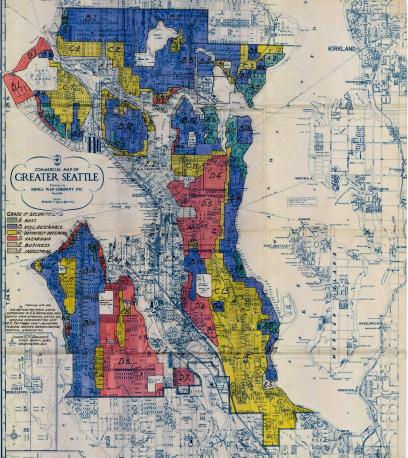
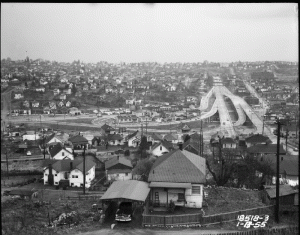
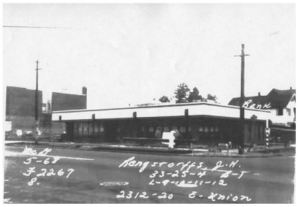
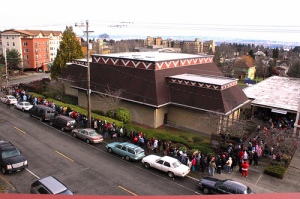
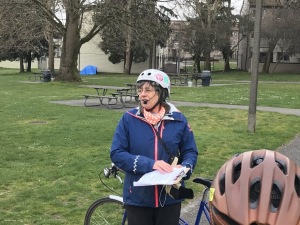
Thank you Merlin. I am so blessed to call you Friend.
Pingback: Biking Seattle’s Redlining: An Interview with Merlin Rainwater – Jasmine Mahmoud